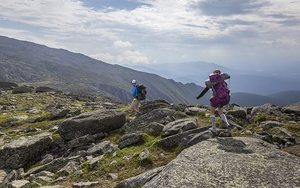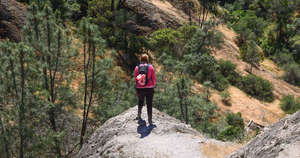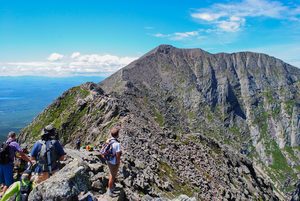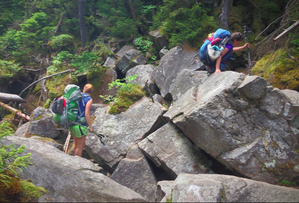The Hardest Parts Of The Appalachian Trail
In this Guide
Of all the three long trails in the US, namely Appalachian Trail, Continental Divide Trail, and the Pacific Crest Trail, the Appalachian Trail provides the most elevation change, making it one of the toughest trails to hike. Covering nearly 2190 miles and extending over fourteen states, this trail may typically take a hiker almost 5 million steps and 5 to 7 months to hike through the entire terrain! The trail is divided into many sections, also known as section hiking. You can hike the Appalachian trail through many of its different sections.
The Appalachian Trail’s difficulty can be gauged by any combination of terrain, trail conditions, weather, time of the year, and/or local novelties. While no part of the Appalachian Trail is unchallenging, some are admittedly way harsher than the others. Rest assured, a hike through the Appalachian Trail will test even the most proficient hikers out there. Yes, you are right; it offers one of the hardest hikes in the United States!
So, if you are looking for an absolutely exhilarating experience, let us take you through some of the hardest and best parts on the entire Appalachian Trail that will make your next hike a little less daunting.
Are you ready for a challenge? Yes? then you should probably keep reading!
Here Are Our Top 6 Picks – Appalachian Trail by State
1) White Mountains (Mount Washington), New Hampshire

Mile Marker: 1,792
Distance: Approximately 100 miles
Highest Point: The White Mountains, notably Mount Washington, is at 6,289 feet. While the lowest points are some “notch” road crossings at roughly 1,400 feet.
Situated in the epicenter of the Presidential Range in New Hampshire’s White Mountain National Forest (simply referred to as “The Whites”). The White Mountains are arguably the most infamous peak of the entire Appalachian Trail. It is interesting to note how this part of the trail is one of the hardest hiking trails in the US because of its tempestuous weather rather than the difficulty of the climb itself. Despite the comparatively low elevation of 6,289 feet, Mt. Washington has held the record for the wildest wind gust for the last 76 years, second strongest to 1996’s Cyclone Olivia (at 253 mph). It exists at the intersection of numerous key storm tracks, which implies that almost every storm traversing west to east across the country travels over its peak. Interestingly, these storms meet with weather systems moving south to north. Therefore, planning is the key to successfully hiking through this challenging section of the trail. It is always better to check the weather report at the nearby Lakes of the Clouds Hut. Just don’t forget to pack some essentials such as rain gears (several layers), energy-dense snacks, and plenty of water before you undertake the summit. The captivating beauty of the White Mountains awaits you!
What makes this section the hardest?
- Inclement weather
- Elevation gain per mile
- Rocky terrain
- Stringent camping regulations
2) Southern Maine
Mile Marker: 1,909
Distance: Approximately 100 miles
Highest Point: North Crocker Mountain at 4,228 feet. The lowest points are road crossings at roughly 1,200 feet.
For all the hikers out there heading North, reaching Maine is a major breakthrough of the journey because this part of the Appalachian Trail is arguably the toughest. It offers a rooted and rocky terrain that does not allow you to take a smooth step for miles at a time! Better be prepared to lower off boulders, pull up on trees, or slide down on your butt. Hikers are slowed to a near crawl as they clamber up steep, eroded sections of trail, and shove their packs around boulders through the one-mile Mahoosuc Notch. Moreover, depending on the season, be prepared to meet battle clouds of gnats and black flies. Don’t be scared! Maine becomes a lot amiable as the trail winds north. Interestingly enough, if you are one of those hikers who tend to appreciate the rugged characteristics of the trail, then Southern Maine is just the perfect section for you to hike on!
What makes this section the hardest?
- Eroded trails
- Mahoosuc Notch
- Terrible terrain
3) Northern Pennsylvania

Mile Marker: 1,150
Distance: Approximately 150 miles
Highest Point: Elevation gain is insignificant. It is one of the flattest parts of the Appalachian Trail, staying approximately between 600-1400 feet for most of the trail.
We can say that this section of the Appalachian Trail is a low-elevation, flat cakewalk. But hikers, you are being forewarned- the footing in this part of the trail will give you the most difficult hike in PA. You will have to traverse the rockiest section of the entire Appalachian Trail for more than 100 miles! As you move forward, the rocks will increase until your feet are bruised and ankles sprained. Some sections don’t even look like a trail. They are just a lot of rocks sticking up at every route with the rare white blaze to let you know that you are still hiking on the trail. Water is infrequent through this section. Some of it might not be potable, and some water locations are down steep side trails. The good news is, the towns through this section offer inexpensive services. So, you don’t have to worry about restocking items in case you run out of them.
What makes this section the hardest?
- Rockiest terrain
- Depending on the conditions, water can be scarce here
4) Mt. Katahdin, Maine

Mile Marker: 2,186
Distance: 10 miles round trip
Highest Point: Mount Katahdin is at almost 5,268 feet. Low points are multiple stream crossings between 650-750 feet.
The highest peak of Mt.Katahdin is the northern terminus of the Appalachian Trail- the endpoint for the northbound hikers. It is also regarded as the longest climb on the entire trail. The Katahdin Stream Campground is at roughly 1,088 feet of elevation, with the highest peak of Katahdin 5 miles north at a soaring 5,268 feet. Hikers use their arms to pull themselves over boulders, grasp rungs drilled into rocks to scramble up, and relish the final, windswept plateau before reaching that magnificent wooden sign marking the termination of the Appalachian Trail. Just like most of the climbs in northern New England, you should better be prepared for harsh weather. Rest assured, it will definitely be worth the effort!
What makes this section the hardest?
- The longest climb on the entire trail
- Hairy sections
- Harsh weather
5) Southern Virginia

Mile Marker: 466
Distance: Approximately 150 miles
Virginia flattens out as hikers head north, but Southern Virginia offers ridge climb after ridge climb for up to 1,000 feet up and 1,000 feet down. As the trail winds about another switchback, it might look like you’ve gained the ridge, only to have the trail turn to disclose more climbing. Virginia is the longest section of the trail- going up to almost 500 miles! Hikers acclimatize to crossing state lines, so spending a month in one state can be demotivating for many.
What makes this section the hardest?
- Ridge climbing
6) New York

Distance: Under 100 miles
Highest Point: One of the lower parts of the trail. Prospect Rock is the highest point at 1,433 feet. The trail has multiple road crossings at roughly 200-300 feet.
New York takes thru-hikers aback because of its challenging steep climbs. While none are long, the abrupt up-and-down climbs take a toll. New York is also considered a burn-out area for Northbounders. The peak of the season finds Northbounders in New York during the warmest time of the year, and the bugs/insects can be really nasty. You cannot ignore the New York delis; if you time it right, you can hit a deli a day through the entire state.
What makes this section the hardest?
- Steep, abrupt, repetitive climbs- many never breaking the treeline
- Stagnant water invites vicious bugs
What are the easiest sections of the Appalachian Trail?
For the people who might not have the time or energy for several month-long thru-hikes, you can still witness the many splendors the Appalachian Trail offers in small chunks. You can easily hike on the Appalachian trail even if you do not have previous experience. Whether you have an afternoon or a couple of weeks to delight in an exhilarating journey, there are many paths for you to explore. We have listed down some of the easiest parts of the Appalachian Trail for your next hiking excursion:
- Springer Mountain, Georgia (75 miles, 8 days)
- Nantahala Mountains, North Carolina (29-mile hike, 3 days)
- Great Smoky Mountains National Park, Tennessee (4 days)
- Iron Mountain Gap to Cross Mountain, Tennessee (17 miles, overnight)
- Taconic Highlands, Massachusetts (16.9 one way, 2 days)
- Delaware River, New Jersey/Pennsylvania (15.9 miles one-way, 2 days)
What are the worst sections of the Appalachian Trail?
One of the worst sections of the Appalachian trail is in Pennsylvania since treacherous rocks are in the state’s northern part.
What is the steepest climb on the Appalachian Trail?
The steepest climb on the Appalachian Trail is from Pinkham Notch to Wildcat E in north-central New Hampshire.
Final Thoughts
Knowing which are some of the hardest sections of the Appalachian Trail is important. Now, you should be careful when passing through the White Mountains, Southern Maine, Northern Pennsylvania, Mt. Katahdin, Southern Virginia, and New York. Knowing what these challenging sections have in store for you is the perfect way to prepare beforehand. Ensure you have the suitable gear and proper food/water supplies for the long journey ahead.

